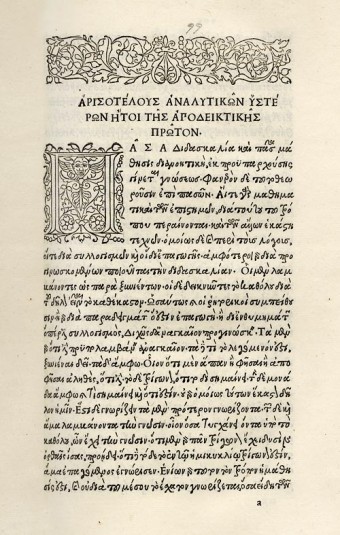When Did People Start Using Punctuation?
INTHEBEGINNINGTHEREWASNOPUNCTUATIONLOWERCASELETTERSOREVENSPACESBETWEENWORDSTHEREALSOWASNOGRAMMATICALWAYOFDISTINGUISHINGWHENANIDEAHADFINISHEDANDANEWONEBEGUNITDIDNTHELPTHATTHEIDEAOFSTANDARDIZEDSPELLINGWASALSONOTATHINGATLEASTNOTASWEWOULDTHINKOFITREADERSWERELEFTTOMUDDLETHEIRWAYTHROUGHANYTEXTASBESTTHEYCOULDUNSURPRISINGLYUNDERSTANDINGWHATAPARTICULARWORKWASACTUALLYSAYINGONTHEFIRSTREADTHROUGHWASPRETTYWELLUNHEARDOFATTHISTIME
 The earliest writings, which were syllabic and/or logographic (think Mayan and Chinese), had no need for either spacing or punctuation, as each word was typically self-contained in the symbol. However, as previously demonstrated, the lack of punctuation and spacing in alphabetic writing made comprehension difficult; so hard, in fact, that in ancient Greece it was a rare feat for an individual to understand a text they were reading the first time through and the idea of reading out-loud to a group without extensive practice beforehand was also not something typically done.
The earliest writings, which were syllabic and/or logographic (think Mayan and Chinese), had no need for either spacing or punctuation, as each word was typically self-contained in the symbol. However, as previously demonstrated, the lack of punctuation and spacing in alphabetic writing made comprehension difficult; so hard, in fact, that in ancient Greece it was a rare feat for an individual to understand a text they were reading the first time through and the idea of reading out-loud to a group without extensive practice beforehand was also not something typically done.
Nonetheless, a few notable exceptions aside, punctuation in the West didn’t really appear until about the end of the 3rd century BC when Aristophanes of Byzantium, head librarian at the Library of Alexandria (see: What Really Happened to the Library of Alexandria?), introduced the precursors of today’s punctuation marks. He suggested inserting dots to indicate where a passage ended and the length of pause needed when speaking a text (useful in aiding knowing how much breath was needed for the following passage). This convention subsequently began to appear in various Greek works and became, to some degree, relatively standardized.
Interestingly, the Greek words that came to be our comma, colon and period were not describing their dotted punctuation marks themselves, but rather the length of the piece of text that was being set apart, to wit: a low mark (hypostigme) denoted a “unit smaller than a clause,” which was known as a komma; a mid-high mark (stigma mese) distinguished a clause or kolon; and a high mark (stigma teleia) denoted an entire sentence, known as a periodos.
The Greeks also introduced a mark to distinguish paragraphs (paragraphos or gamma), and set off quotations with diples.
Not everyone was a fan of these marks. Given that their entire purpose was not syntactical but, rather, elocutionary, many, like the famous Roman orator Cicero (106-43 BC), scorned such punctuation, noting things like when and how long to pause for breath “ought to be determined not… by a stroke interposed by a copyist, but by the constraint of the rhythm.”[1]
Thanks to the influence of the Romans, the punctuation introduced by the Greeks languished as the oral tradition of Rome dominated. However, once Christianity began to spread across Europe via written texts, its scribes began punctuating again in order to try to preserve the original meaning of the Word. (As Lynne Truss famously notes, there is a big difference between “eats, shoots & leaves” and “eats shoots and leaves.”)
In addition, by the 7th and 8th centuries, spaces between words were becoming more common (and are said to have been invented, or at least popularized, by Irish and Scottish monks of this era who were tired of wrestling with separating unfamiliar Latin words). At the end of the 8th century, Charlemagne is generally credited with the introduction of lowercase letters after requesting that the monk Alcuin develop a unified alphabet, which ultimately included these. (See: The Origins of the English Alphabet)
With the rise of the printing press a few centuries later, the numerous conventions (and symbols) used in punctuation became a bit of a problem for printers, something that had not been as much of an issue when things were simply written by hand. Enter Aldus Pius Manutius, a prominent Italian publisher and printer of the 15th century who, besides famously introducing “pocket editions” of Greek and Roman classic works meant for mass consumption and relatively inexpensive to purchase, also seems to have been the first typographer to use the comma and semicolon. (He also helped develop italic type with the help of Venetian punch-cutter Francesco Griffo. Interestingly, Griffo seems to have met an untimely end after he beat his son-in-law to death with an iron bar and is presumed to have been executed for this crime- after being charged with this murder, there is no further record of him.)
Aldus’ grandson, Aldo Manutius the Younger (1547-1597) took over the family printing business at the age of just 14. Not long after, he codified the modern, standardized use of comma, colon and period, publishing a book on the subject in the early 1560s called Orthographiae ratio (A System of Orthography). In the book, Aldo built on the ancient Greeks’ minimal punctuation marks and designated that the comma would separate phrases and clauses, the colon would be used for lists, and the “full point” (read: period) would denote the end of the sentence. Aldo also explained the uses of other basic punctuation including the question mark, apostrophe, exclamation point and quotation marks.
Aldo also explicitly noted that the purpose of these marks was more than merely as a rhetorical aid, but that such marks were necessary in order to express and preserve meaning (as previously identified by the Christian scribes centuries earlier).
For English writers and printers, however, while they did begin almost universally using the marks Aldo had expounded upon, punctuation remained widely thought of as primarily for elocution, and authors including George Puttenham in The Arte of English Poesie (1589) and Simon Daines in Orthoepia Anglicana (1640) even set out a standard for the proper use of a comma, semicolon and colon as simply a “pause of one unit . . . two units . . . and of three,” respectively.
This began to change after the publication of Ben Jonson’s English Grammar (1640) in which he illustrated how punctuation could help preserve an author’s original intention, rather than just giving a guide to how to read a text out-loud. Well received, by the time of the Restoration (1660), using punctuation for syntactical purposes was finally common, and in fact, by the 18th century, excessive punctuation (such as placing a comma between every possible phrase) had become a major problem.
Overuse of punctuation continued to some extent through the late 19th century until lexicographers Henry Watson Fowler and Francis George Fowler published The King’s English (1906), which called for far less and established the style of “light punctuation” that endures to this day.
If you liked this article, you might also enjoy our new popular podcast, The BrainFood Show (iTunes, Spotify, Google Play Music, Feed), as well as:
- The Real Origin of the Mathematical Convention of Using “X” as the Unknown
- Is it Really Not Grammatically Correct to End Sentences With a Preposition?
- Did English Speakers Really Not Use Contractions in the 19th Century as Depicted in True Grit?
- Are Split Infinitives Like “To Boldly Go” Really Not Correct Grammatically?
- Who Invented the Emoticon?
- Shady Characters, The Secret Life of Punctuation, Symbols & Other Typographical Marks
- Ancient Roots of Punctuation
- Cicero
- English Restoration
- History of Punctuation of English Writing
- The Italian 100
- Aldus Manutius
- Marking the Untellable (Sweet)
- Mesha Stele
- The Mysterious Origins of Punctuation
- Punctual Punctuation
- Punctuation
- Punctuation in English since 1600
- Francesco Griffo
- Notes
- [1] Sweet at 18
| Share the Knowledge! |
|






I quote from the article:
“Overuse of punctuation continued to some extent through the late 19th century until lexicographers Henry Watson Fowler and Francis George Fowler published ‘The King’s English’ (1906), which called for far less and established the style of ‘light punctuation’ that endures to this day.”
I found this sentence to be quite ironic, because it is, in my opinion, slightly UNDERpunctuated. I would have used a comma between “Century” and “until.” Notice that I also advocate capitalizing “century” when a specific hundred-year period is mentioned. The use of lower case (“century”) after “19th” is, in my view, analogous to someone’s erroneously writing, “Middle ages,” instead of, “Middle Ages.”
I strongly believe in a moderate use of commas, hyphens, and parentheses for better comprehension. While they serve several purposes, they can act as signals that the brain should pause momentarily before continuing — as in the suggested case of, “Century, until,” in the sentence quoted above.
When I was taught to write, in the 1950s and 1960s, neither “light punctuation” nor overpunctuation was required of me — but, instead, a “happy medium.” That was in the American Midwest, where people were not (thank Heaven) exposed to the book, “The King’s English.” I have struggled to understand several articles at “Today I Found Out,” in part because of (overly) “light punctuation” and in part because of the use of run-on sentences.
Thanks for the very interesting information in this article!
I always assumed that you use a comma when you’re trying to add, in a small way, something that was just said, and that if you continue the thought after the comma, you use a comma at the end of that thought to denote that you were moving on. If I must distinguish a second thought in the midst of my first thought after a comma, I then use the dash (or double dash) — as evidenced between seven and eight words ago; however, I’m fairly confident that no one knows how to properly use the semi-colon.
I would debate the use of a comma after “Century, until” as the author is continuing the phrasing of his or her original thought. I would choose to use a comma, though, here: “,which called for far less(,) and established…” However, I think that would be along the lines of the Oxford Comma debate, which I care not to get into… 🙂
I also appreciate the emphasis on certain words or thoughts in a sentence, but prefer to use italicized text instead of ALL CAPS when available. In my humble opinion, moderate amounts of capitalization are equally as important in the entirety of the United States as it is in the American Midwest, although I am from the Midwest as well.